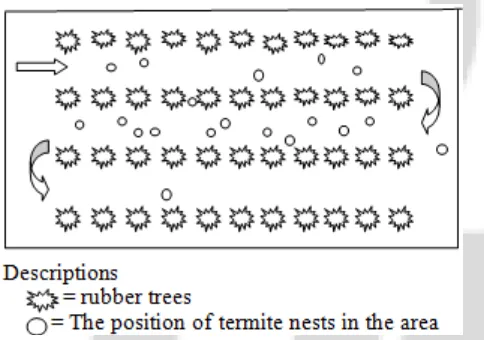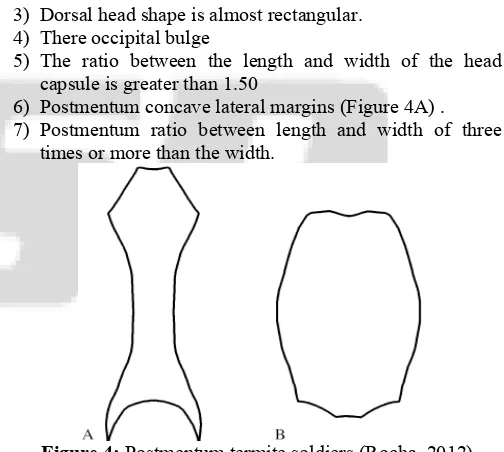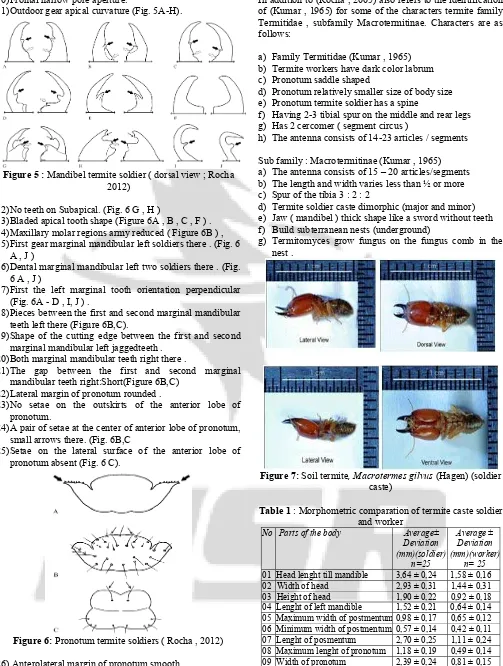Characteristics, Morphometry and Spatial
Distribution of Populations of Subterranean
Termites
Macrotermes Gilvus
. Hagen (Isoptera:
Termitidae) in the Rubber Plantation Land Habitat
Which Managed Without Pesticides and Chemical
Fertilizers
Zainal Arifin1., Zulkifli Dahlan2., Sabaruddin3., Chandra Irsan4., Yusuf Hartono5
1, 5
Faculty of Teacher Training and Education Sriwijaya University
2
Faculty of Sciences and Mathematics Sriwijaya University
3, 4
Faculty of Agriculture Sriwijaya University, Palembang, Indonesia
Abstract: Found 39 termite mound nests in a variety of sizes in the land of rubber plantation covering approximately 2 acres , which is
administered without the use of chemical fertilizers and pesticides . Do the location and size of the nest census for mapping the spatial distribution of nests. Termite sampled randomly for identification , morphometry. Physico - chemical of soil conditions such as temperature, pH and humidity ( Rh ) of land are measured. In dryland ecosystems, such as rubber plantations, the role of termites in nutrient cycling is important, because the ground surface covered by litter dropping dead leaves and twigs of the plant rubber. Land conservation practices carried out in land management, such as the omission of the rubber plant falls on the surface of the soil, without the use of pesticides and chemical fertilizers. The purpose of the study to identify the significance of a rubber plantation land resources due to the presence of subterranean termites, such as the suitability of habitat for species of termites that build nests. Additionally soil termites Macrotermes gilvus ( Hagen ) is an important decomposers in litter decomposition in arid land, therefore need to know the characteristics, morphometry and spatial distribution of species populations. Nest distribution ( population ) is important to know availability of land as habitat for termites. Therefore, the study and discussion of the above is done.
Keywords:spatial distribution, characteristics, morphometry, Macrotermes gilvus ( Hagen ) rubber plantation
1.
Introduction
The niche of termites in a habitat can be known when the habitat occupied by termites. At the macro level, the rubber plantation land habitats where the study was conducted occupied by termites. The indication was found that subterranean termites nest is quite a lot and spread almost in all parts of rubber plantation land. This situation is possible because of the vegetation and relatively uniform treatment of the land, such as management without the use of chemical fertilizers and pesticides. In addition, the rubber plants in land have the same age and treated let fall- foliage leaves buried in the ground.
Conditions of biotic factors and / or local abiotic, especially the abundance of plants, plant diversity, plant species and entropic disturbances can disrupt termite density and distribution patterns in a habitat. In a more favorable environmental conditions, the termite population will grow well. There is a relationship between termites and biotic factors, in particular the distribution, density and vegetation species, as well as with the abiotic factors of habitats, especially soil temperature and soil moisture by setting ground termite populations within the habitat. Termite species build nests underground and the need to build a nest material such as sand, silt and clay in an sufficient amount to
deposit materials for termite nests and nest building gallery (Lee & Wood , 1971 b). Sandy soils, for example, has a small amount of good material to deposit the nest, so in this situation less ground termite nest building was found (Jones
et al., 2000; . Jouquet et al., 2000). The study of the
distribution of termites, a suitable environment is a fundamental in the analysis of termite populations in a habitat . This provides important information about the life and the termite population dynamics in habitat, and population regulation processes, such as competition (Haase, 1995). How does the spatial distribution of termites in a system environment is a major question in ecology and interesting to study .
Microhabitat variations such as concentration of soil nutrients, including carbon, hydrogen and nitrogen (Richard,
et al., 2006), including side effects and the gap vegetation, is very important in distribution Isoptera colony. Climatic conditions such as temperature, humidity and precipitation, as well as habitat characteristics such as soil type and depth is also important to understand the distribution of
subterranean termites(Hulugallem, et al., 1997). The
Volume 3 Issue 4, April 2014
nests on the ground. Despite of termite resources available and abundance, if the micro-conditions of physico-chemical of habitat can not be tolerated by termites, the termites will not occupy the habitat. Termites are poikiloterm insects, where there is a direct influence of environmental temperature on body temperature. In termites, the maximum rate of metabolism is at ambient temperature conditions that provide optimal body temperature for the process of metabolism. Therefore, it is important to know the condition of the soil physico - chemical to termite to build a nest in the habitat. This study aimed to identify the characteristics of termites, termite morphometry, the spatial distribution of nests and soil physico-chemical conditions of the rubber plantation land where termite nests are found.
2. Materials and Methods
The study was conducted in Tanjung Batu subdistrict, Ogan Ilir regency, South Sumatra Palembang, Indonesia. Location of the study are in the Wet Tropics region with climate (B type) and dry season ranges from May to October, while the wet season ranges from November to April. Average rainfall 1159.25 mm per year and the average number of rainy days 59 days per year. Daily air temperature ranged from 230 C to
320 C and the daily humidity ranged between 69% to 98%.
a. Census number of nests
Census conducted on all existing subterranean termites nest in the study area. Each measured the length, width and distance of the nest to the nearest gum tree. This is done sequentially by tracing around the rubber plantation land. Sketch how a search as shown below.
Figure 1: Sketch job search subterranean termites nest
From this search, images generated "map" of the spatial distribution of subterranean termites nest in the soil and the size of the nest and nest distance to the nearest gum tree with the nest against the distance measurement. Rubber tree, is used to determine the location of the nest on land, and visualized in the form of images "map" the distribution of nests in the study area by using Microsoft office visio computer programe.
b. Characterization and morphometry termite species
A number of termites taken from the nest, by way unpacked it carefully so damage can be minimized. 25 termites are
drawn at random for each caste of workers, and soldiers. Sample is introduced into a solution of 75% alcohol preservative. Furthermore, the identification procedure followed by Rocha (2012), Krishna, 1965), and morphometric of each caste termites measured.
3. Results and Discussion
3.1 The spatial distribution of termite mounds
To determine the role of termites in a habitat can only be known if a habitat occupied by termites. Overall, macro rubber plantation sites is the habitat occupied by termites. Indication, many termite nests were found in habitats with different sizes and scattered in almost all parts of rubber plantation land. The diversity of nest size shows conditions of termite population growth in the share of age. Although the number of nests varies from section to section of land but the nest was found in almost all parts of the land. This situation is due to the land managed organically. The major crops grown in the area is that just rubber plant at the same cohort. The land is managed without the use of pesticides and chemical fertilizers, and treatment omission dropping leaves and twigs buried in the ground.
The difference in the number and size of the nests at the habitat, assume, because of specific factors of physico-chemical conditions. These factors still need to know more to understand the micro- environmental conditions of the habitat, where the termite nest placing. So, the next study will be done. This is important, because the fact that there is enough food resources or abundant in the habitat. When the soil physico-chemical conditions are not within the tolerance of termites, the termites will not occupy the habitat and build nests despite the availability of food abundance. The regular
distribution of Macrotermes nests seems to be indirectly
caused by food deprivation (Korb & Linsenmair, 2001). Termite food source to within a few centimeters to more than 50 meters from the nest, depending on species and size of the colony. Several species of food available in the open, while termites spend entire existence in the nest system (Wood,1988). For example, families Hodotermitidae termites, termite meadow is a semi - arid areas, and has progressed well with the nests are built far from the source of food (Engel, et al. , 2009). Termites are insects that are poikilotermi response to temperature, where there is a direct influence of environmental temperature on body temperature. The body temperature effect on the performance of the metabolism of termites. The highest of metabolism will occur at optimal environmental conditions within the tolerance range of termites. So, to know the physico-chemical and environmental microhabitat conditions is important in order to understand about the selection of soil for placing nest of termites in the soil and the role of termites in a habitat
relatively equal chances for termite to place a nest. Distribution of nests on land as can be seen in Figure 2 :
Figure 2: Distribution of termite nests in the Land of Rubber Plantation
Chi - Square value of physico - chemical conditions of the soil between the size of the nests
1 Nest soil temperature 5,729
2 Soil temperature near the nest 3.846
3 Nest soil pH 0.561
4 Soil pH near the nest 2.465
5 Rh soil nests 0.196
6 Rh soil near the nest 5,068
All test values is smaller than the value of Chi - square of 0.05 table = 5.99
Mapping results show a relatively uniform distribution of nests or exist in all parts of the land. This indicates that the rubber plantation land has a relatively homogeneous condition in tolerable by termites as habitat. The range of soil conditions of pH 6.2 - 6.6, Rh. 20 – 31% and tempature 26 - 280C. Similarly, the size of the nests are small, medium or large is found, there is in all parts of the study area, although in different amounts. Termite nest is the main space colony life, and the size of the nest express the age and density of population. Relatively permanent nest building and occupied by termite in a long priode, seen from the Existance of the nest on land. The fact that different nest sizes showed invasion of termite in the soil does not occur at the same time. There are several sizes nest, the nest catagorized as large, medium and small and its show deferent age of the nest. There are even suspected overlap nests were found where more than one nest or colony of termites at the place. This assumption is because the second nest showed no significant difference in the size compared to the other closed nest. Further information is still needed.
3.2 Characteristics and Morphometry Species
Termites are samples of soldier caste. The characters were observed to follow(Rocha, 2005) although the focus of this taxonomic characters used for Syntermitinae subfamily, but are taxonomically closely related to the subfamily Macrotermitinae, both included in the family Termitidae. The character is to provide further information neighbor subterranean termites studied, characters are as follows :
1) hyaline tip protruding labrum (Fig. 3C, D) .
2) Anterolateral margin of the labrum is lost (Fig. 3B, D) .
Figure 3: Type of soldier termites Labrum (Rocha, 2012)
3) Dorsal head shape is almost rectangular. 4) There occipital bulge
5) The ratio between the length and width of the head capsule is greater than 1.50
6) Postmentum concave lateral margins (Figure 4A) . 7) Postmentum ratio between length and width of three
times or more than the width.
Figure 4: Postmentum termite soldiers (Rocha, 2012)
8) Small dots on the head capsule compose striking and characteristic no microsculpture
Volume 3 Issue 4, April 2014
10)Frontal narrow pore aperture.
11)Outdoor gear apical curvature (Fig. 5A-H).
Figure 5 : Mandibel termite soldier ( dorsal view ; Rocha 2012)
12)No teeth on Subapical. (Fig. 6 G , H )
13)Bladed apical tooth shape (Figure 6A , B , C , F ) . 14)Maxillary molar regions army reduced ( Figure 6B ) , 15)First gear marginal mandibular left soldiers there . (Fig. 6
A , J )
16)Dental marginal mandibular left two soldiers there . (Fig. 6 A , J )
17)First the left marginal tooth orientation perpendicular (Fig. 6A - D , I, J ) .
18)Pieces between the first and second marginal mandibular teeth left there (Figure 6B,C).
19)Shape of the cutting edge between the first and second marginal mandibular left jaggedteeth .
20)Both marginal mandibular teeth right there .
21)The gap between the first and second marginal mandibular teeth right:Short(Figure 6B,C)
22)Lateral margin of pronotum rounded .
23)No setae on the outskirts of the anterior lobe of pronotum.
24)A pair of setae at the center of anterior lobe of pronotum, small arrows there. (Fig. 6B,C
25)Setae on the lateral surface of the anterior lobe of pronotum absent (Fig. 6 C).
Figure 6: Pronotum termite soldiers ( Rocha , 2012)
26) Anterolateral margin of pronotum smooth .
27)Anterolateral margin of mesonotum metanotum and smooth .
28)Row 5 or 6 thick no setae on first coxae. 29)Tibial spurs : 2:02:02 .
30)Fore coxae hump shape of the outer margins .
In addition to (Rocha , 2005) also refers to the identification of (Kumar , 1965) for some of the characters termite family Termitidae , subfamily Macrotermitinae. Characters are as follows:
a) Family Termitidae (Kumar , 1965) b) Termite workers have dark color labrum c) Pronotum saddle shaped
d) Pronotum relatively smaller size of body size e) Pronotum termite soldier has a spine
f) Having 2-3 tibial spur on the middle and rear legs g) Has 2 cercomer ( segment circus )
h) The antenna consists of 14-23 articles / segments
Sub family : Macrotermitinae (Kumar , 1965) a) The antenna consists of 15 – 20 articles/segments b) The length and width varies less than ½ or more c) Spur of the tibia 3 : 2 : 2
d) Termite soldier caste dimorphic (major and minor) e) Jaw ( mandibel ) thick shape like a sword without teeth f) Build subterranean nests (underground)
g) Termitomyces grow fungus on the fungus comb in the nest .
Figure 7: Soil termite, Macrotermes gilvus (Hagen) (soldier caste)
Table 1 : Morphometric comparation of termite caste soldier and worker
No Parts of the body Average±
Deviation (mm)(soldier)
n=25
Average ± Deviation (mm)(worker)
n= 25
4. Conclusion
Species identified as subterranean termites Macrotermes
gilvus (Hagen) (Termitidae; Macrotermitinae). Termite nest
uniformly distributed in the rubber plantation land habitats with varying in sizes as impact of no chemical fertilizer and pesticides, the land just managed organically. Soil physico-chemical conditions such as temperature, relative humidity (Rh) and pH. Of rubber plantation indicated suitable and
tolerance habitat for subterranean termites M. Gilvus
(Hagen). There have strenght morphometric differences between caste soldier and caste worker of the termite.
References
[1] Engel MS, Grimaldi DA, Krishna K. Termites (Isoptera): their phylogeny, classification, and rise to ecological dominance. Am Mus Novit (2009): 3650, 1–27
[2] Hulugalle, N.R.; Lobry De Bruyn, L.A. & Entwistle, P. Residual effects of tillage and crop rotation on soil properties, soil invertebrates numbers and nutrient uptake in anairrigated Vertisol sown to cotton. Applied Soil Ecology,(1997): 7, 11 - 30.
[3] Haase, P. Spatial pattern analysis in ecology based on Rip-ley’s K - function: introduction and methods of edge cor-rection. Journal of Vegetation Science, (1995) :6, 575. [4] Jouquet, P.; Lepage, M. & Velde, B. Termite soil
preferences and particle selections: strategies related to ecological requirements. Ins ectes Sociaux, (2000) : 49, 1 - 7.
[5] Jones, David T and Eggleton, P. Sampling termite assemblages in tropical forest : testing a rapid biodiversity assessment protocol. Journal of applied Ecology (2000) :37, 191-303.
[6] Krishna, kumar. Termites (Isoptera) of Burma. The American Museum of Natural History Central Park. (1965) :Number.2210, 1 – 37.
[7] Korb, J. & Linsenmair, K.E. The causes of spatial patterning of mounds of a fungus-cultivating termite: results from nearest-neighbour analysis and ecological studies. Oecologia, (2001):127,324–333.
[8] Lee KE, Wood TG. Physical and chemical effects on soils of some Australian termites and their pedological significance. Pedobiologia (1971 b) ;11,376 – 409 [9] Richard, J.F.; Baddi, G.A.; Costa, C.; Guiresse, M.;
Kaemmerer, M.; Hafidi, M. & Revel, J.C. Comparative study on humic acids of the mound of a wood - feeding termite and of the litter directly below in the Amazon river delta. Chemistry and Ecology, (2006) :22, 201 - 209, 2006.
[10] Rocha M M, Cancello E M, Carrijo T F. (2012). Neotropical termites : Revision of Armitermes Wasmann ( Isoptera, Termitidae, syntermitinae ) and Phylogeny of the syntermitinae. Systematic Entomology, 37, 793 – 827.
[11] Wood, T. G., ( 1988). Termite and the Soil Environment. Biol.Fertil.Soil (1988) : 6 , 228 – 236.
Author Profile
Zainal Arifin is a Ph.D. candidate in Environmental Sciences.


